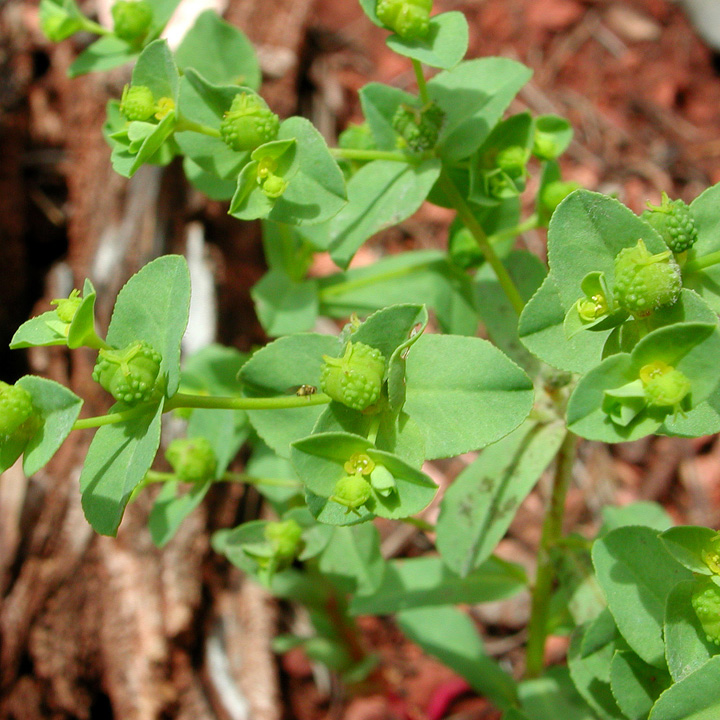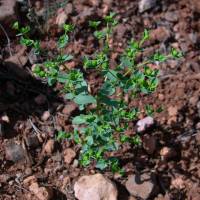|
|
|
|
Family: Euphorbiaceae
warty spurge
[Euphorbia arkansana Engelm. & A.Gray, moreEuphorbia dictyosperma Fisch. & C.A.Mey., Euphorbia obtusata Pursh, Galarhoeus arkansanus (Engelm. & A.Gray) Small ex Rydb., Galarhoeus obtusatus (Pursh) Small ex Rydb., Tithymalus arkansanus (Engelm. & A.Gray) Klotzsch & Garcke, Tithymalus missouriensis (Norton) Small, Tithymalus obtusatus (Pursh) Klotzsch & Garcke, Tithymalus spathulatus (Lam.) W.A.Weber] |
Glabrous annual, 2-7 dm, simple to the umbel or with a few lateral branches; cauline lvs oblong-oblanceolate, 1.5-4 cm, very obtuse, finely serrulate, subcordate and somewhat clasping at the sessile base; lvs subtending the primary umbel shorter and broader, those of the umbel broadly ovate; rays of the primary umbel usually 3; involucres 1.5 mm, strictly glabrous outside; styles separate to the base, each bifid a third to half its length; fr 3-3.5 mm, verrucose; seeds thickly lenticular, 2-2.5 mm and nearly as wide, smooth or obscurely reticulate. Woods; Pa. to Ind. and Io., s. to S.C. and Tex. Apr., May. (Tithymalus o.; Galarhoeus o.) Gleason, Henry A. & Cronquist, Arthur J. 1991. Manual of vascular plants of northeastern United States and adjacent Canada. lxxv + 910 pp. ©The New York Botanical Garden. All rights reserved. Used by permission. Kearney and Peebles 1969, McDougall 1973 Duration: Annual Nativity: Native Lifeform: Forb/Herb General: Glabrous annual to 45 cm tall, simply branching to just below the inflorescence, stems deep red to green. Leaves: Alternate, oblong to spatulate, to 4 cm long, margins serrulate, sometimes red-tinged, especially near the tips, sessile or borne on short petioles, leaves which subtend the inflorescence opposite, elliptic to ovate, sessile, with crenulate margins, forming a cup around the inflorescence, these sometimes lighter in color than the surrounding leaves. Flowers: Inflorescences borne in forked rays, 3-rayed or born on several short branches with 1 or more cyathia, involucres campanulate, to 1 mm long, glands yellow, oval, without appendages, not concealed. Fruits: Globose capsules to 3 mm long, warty, with warty brown or black seeds to 1.5 mm long. Ecology: Found on plains and hills from 3,500-7,500 ft (1067-2286 m); flowers March-April. Notes: Distinguishing characters for this species are the yellow involucre glands without appendages and the warty capsules. Ethnobotany: Specific use of the species is unknown, but the genus was used as an infusion to treat diabetes, mouth, and skin sores, and as a bath to treat fevers, chickenpox, smallpox, and gonorrhea. In infusion of the roots was taken to invoke diarrhea. Etymology: Euphorbia is named for Euphorbus, Greek physician of Juba II, King of Mauretania, while spathulata means shaped like a spatula. Synonyms: Many, see Tropicos Editor: LCrumbacher, 2011 |
|
|
|



